The 10 Most Beautiful Temples and Monasteries in Mongolia
- olivier05
- 18 nov. 2022
- 4 min de lecture
Dernière mise à jour : 17 sept. 2024

Mongolia is a land of travel and adventure at its core. It is an essential destination when traveling in Asia. It is one of the last countries where nomadic culture is preserved and a nation rich in its diverse and varied natural landscapes. But it is also a country rich in its Buddhist heritage, evident through its various monasteries and temples that have played a major role in the development and spread of Buddhism across Asia.
#1 Erdene Zuu Monastery

Erdene Zuu Monastery, built in 1585 by Abatai Sain Khan, is the oldest Buddhist monastery in Mongolia. It is located in the Ovorkhangai aimag, near Karakorum, the ancient capital of the Mongol Empire of Genghis Khan. This sanctuary is protected by a large surrounding wall with 108 stupas, symbolizing the number of beads in a Buddhist rosary (mala). Damaged at the end of the 17th century, it was restored in the mid-18th century. It is one of the few monasteries that was partially spared during the communist purge organized by Choybalsan. The site is classified as a UNESCO World Heritage site.
#2 Gandantengchilen Monastery

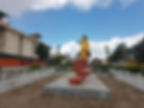
The Gandantegchinlen Monastery, commonly known as Gandan, is one of the must-visit places in Ulaanbaatar. Its original Tibetan name means "the great place of complete joy."
Inside the main temple, Janraisig, there is a 26.5-meter-tall statue of Buddha in his bodhisattva form, Avalokiteshvara. The site includes several temples that showcase the various styles of Buddhist temples found in Mongolia: Mongol-Tibetan, Mongol-Chinese, Mongol, or Tibeto-Chinese. Currently, about a hundred monks officiate in the temple.
#3 The Bogd Khan Winter Palace

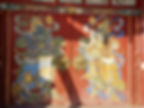
The Winter Palace of Bogd Khan is primarily known today as the last residence of Bogd Khan, and it is the only one of his four residences that still stands. However, it's important to note that it was also a place of worship featuring numerous Chinese-style temples within its compound. The site was constructed between 1893 and 1903.
Today, it is a museum where you can explore a wealth of artifacts from the last emperor, Bogd Khan, of Mongolia. The site is located in the Zaisan district of Ulaanbaatar, just before the bridge that crosses the Tuul River.
#4 Choijin Lama Temple

The Choijin Lama Temple is a small temple nestled in the heart of the business district of Ulaanbaatar, behind the Blue Sky Tower and Sukhbaatar Square. The temple was constructed in 1908 in honor of Bogd Khan's brother. The complex consists of 6 temples.
The temple was active until 1937 when it was closed by the communist regime. It is now an intimate museum that exhibits an interesting collection of papier-mâché sculptures, masks, as well as depictions of hell and the tortures inflicted on sinners
#5 Dashchoilin Monastery
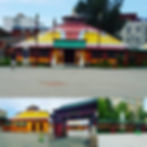
The Dashchoilin Monastery is a lesser-known monastery in Ulaanbaatar, yet it is the second most significant in terms of its activity (housing 100 monks), following only the Gandan Monastery.
This monastery is intriguing due to its typical Mongolian architecture, with temples shaped like yurts. The site was closed in 1939 and was only restored in 1990 with the fall of the communist regime.
It is also known for being the sole place where certain forgotten rituals are still practiced, such as the religious mask dances of Maitreya and Tsam, performed annually. Currently, a monumental golden Buddha statue is under construction within the temple grounds.
#6 Dambadarjaa Monastery
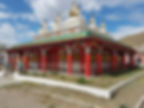
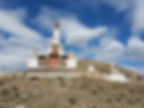
Dambadarjaa Monastery is one of the lesser-known monasteries among foreigners who visit Mongolia. This monastery, located in the northeastern part of Ulaanbaatar, amidst the ger (yurt) districts and hashaa (brick houses), is, however, the oldest in the city. It was built between 1761 and 1765. Originally consisting of 25 buildings, only 2 temples remain today. During World War II, it served as a hospital for Japanese prisoners of war. It's a place well worth visiting.
#7 Monastère Tövkhön

Le Monastère de Tövkhön se situe à une altitude de 2312 mètres, au sommet de la montagne sacrée Shireet Ulaan. Entouré de roches et de forêts de mélèzes, il domine la vallée de l’Orkhon. Le monastère fut construit en 1651 par le jeune Zanabazar alors âgé de 14 ans. Zanabazar, qui était un sculpteur doué, ainsi qu’un peintre et musicien, utilisa pendant plus de 30 ans le monastère, à l’origine appelé Bayasgalant Aglag Oron, « Pays de solitude heureuse », pour sa retraite personnelle. Une cellule lui était réservée dans laquelle il venait se recueillir. C’est dans cette petite cellule de pierre qu’il aurait composé l’alphabet Soyombo, ainsi que plusieurs de ses œuvres les plus célèbres
#8 Zayan Gegeen Temple

It was the monk Zayan Gegeen who, in 1616, created the monastery and the village of Tsetserleg that surrounds it to the south of Bulgan Mountain. It is said that he reincarnated three times.
The ancient temple of Zayan Gegeen was restored in 1951. After serving as a warehouse during the communist regime, it was transformed into an ethnic museum. It has, therefore, ceased all religious activities today. Made of wood, stone, blue bricks, and tiles, its architecture is inspired by Tibetan, Tibeto-Mongolian, and Sino-Tibetan styles.
The first floor of the central building consists of three temples containing the remains of the three Zayan Gegeen. The site was made up of several temples and could accommodate 1,000 monks, or even 4,000 for certain religious ceremonies. Two Tibetan-style wings were added in the 19th century..
#9 Amarbayasgalant Monastery


Located in northern Mongolia, near the Selenge River in the Iven Valley and at the foot of Mount Buren-Khaandans, Amarbayasgalant Monastery is one of the three largest centers of Tibetan Gelugpa Buddhism in Mongolia, also known as the Yellow Hat sect. The monastery was constructed between 1727 and 1737, and it is the only monastery that completely escaped destruction by the communists.
The architecture of the monastery is primarily of Chinese inspiration, with some elements influenced by Mongolian and Tibetan styles, creating a majestic sanctuary.
#10 Khamar Monastery

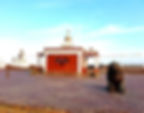
The Khamar Monastery is located near the town of Sainshand in Eastern Gobi (Dornod Govi aimag). This monastery was built in 1821 on the initiative of Danzan Rabjar and is one of the most important centers of Mongolia's Red Hat sect. It was destroyed during the purges of the 1930s and reconstruction was completed in 2006.
This is a significant place in Mongolian Buddhism and for Buddhists in general. It is considered an energetic center and serves as the gateway to Northern Shambhala, a mythical realm in Tibetan Buddhism. Pilgrims often lie on the desert sand to absorb the energy of the earth.








